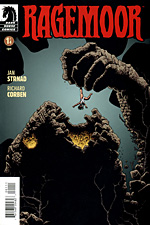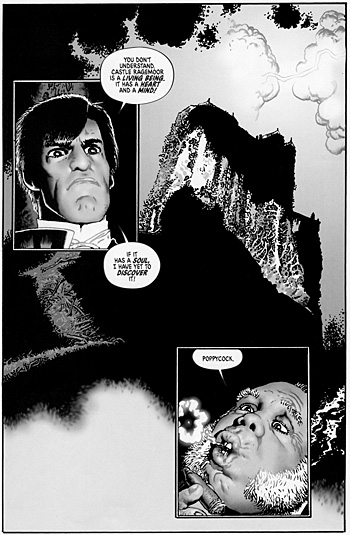 Written by Jan Strnad
Written by Jan Strnad
Art by Richard Corben
32 pages, black and white
Published by Dark Horse
When I think of a creepy old mansion with family members who refuse to leave, Edgar Allan Poe’s The Fall of the House of Usher immediately leaps to mind. It certainly feels like the initial spark behind Jan Strnad and Richard Corben’s Ragemoor, a new mini-series from Dark Horse Comics. But where The Fall of the House of Usher quickly chronicled the end of the House of Usher (both in terms of the family line as well as the physical structure), Ragemoor is a construction that quickly proves itself to have quite a bit of life left in it.
The early pages of Ragemoor #1 open fairly simply. Herbert explains to his uncle and cousin that they should not have returned to Castle Ragemoor, at first hinting and then outright stating that the Castle drives people (including his father) mad, and that the Castle is somehow alive. And from there, amidst the doubt of Herbert’s relatives, Strnad plunges directly into the horror that is Ragemoor. Considering that this is just the first quarter of the overall story, it’s impressive on how it’s able to shift so rapidly from hints and insinuations into something that’s impossible to ignore. It’s around the halfway point of the first issue, when Herbert starts to describe the creation of Castle Ragemoor, that Ragemoor feels like it’s shaken off the shackles of that initial spark of inspiration and moved into a decidedly different direction, and I like it.
 Ragemoor under Strnad’s direction becomes as much Poltergeist as a gothic horror; moments of terror that lunge into the scene with no warning, even as it’s hard to shake a larger feeling of dread hanging over the entire construct. I think that’s ultimately what sold me on Strnad’s writing for the comic; anyone can have things pop into view and scare the audience, but in some ways they almost serve as a deliberate distraction from the big picture that continues to creep up on you as the comic progresses. I’m not sure where Ragemoor will go with three more issues ahead, but Strnad has firmly grabbed my attention.
Ragemoor under Strnad’s direction becomes as much Poltergeist as a gothic horror; moments of terror that lunge into the scene with no warning, even as it’s hard to shake a larger feeling of dread hanging over the entire construct. I think that’s ultimately what sold me on Strnad’s writing for the comic; anyone can have things pop into view and scare the audience, but in some ways they almost serve as a deliberate distraction from the big picture that continues to creep up on you as the comic progresses. I’m not sure where Ragemoor will go with three more issues ahead, but Strnad has firmly grabbed my attention.
As much as I’ve loved Corben’s recent collaborations with colorists like Jose Villarrubia, his black and white work here is exceptional. Corben draws Herbert almost as if he’s carved out of stone in that initial glimpse, a living gargoyle of Castle Ragemoor. As the comic progresses, Herbert gains a little life (and to be honest, occasionally looks more like a Muppet than a person), but every time Herbert draws back in anger and fear to explain to his uncle the danger that is Castle Ragemoor, it’s a beautiful gothic moment; all we’re missing is one of the Bronte sisters to complete the scene. But while Herbert and the servant Bodrick are straight out of those classic pieces of literature, the uncle is drawn in a foppish, cartoonish manner. It’s hard to tell if Corben is trying to signal how out of place the uncle is (even cousin Anoria fits in well enough with her new surroundings), or if he’s simply being played for comedy. Either way, though, the character certainly stands out in an interesting manner, and his presence is certainly bothersome whatever the reason.
Ragemoor #1 is a good opening issue. It establishes the setting of Castle Ragemoor and its few inhabitants well, and both presents a mystery and then immediately moves it into new territory. There are a lot of possibilities for the remaining three issues, and based on what Strnad and Corben have shown us here, it should be a fun ride. Ragemoor is an unexpected little treat of horror and dread. Those who like horror comics should definitely take a gander.
